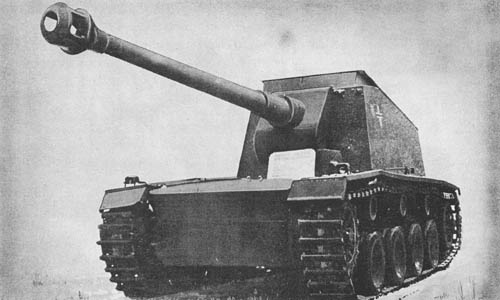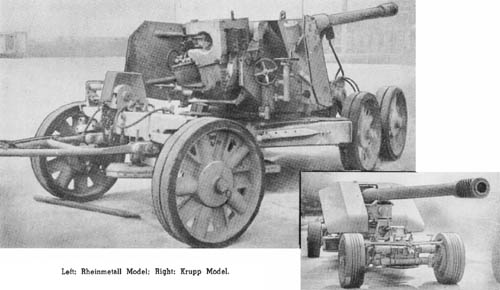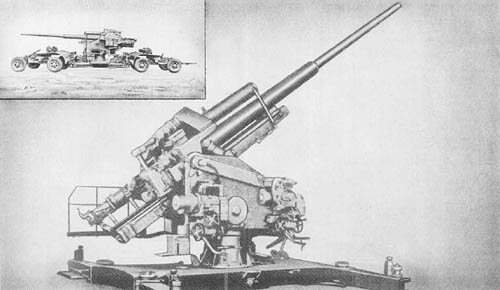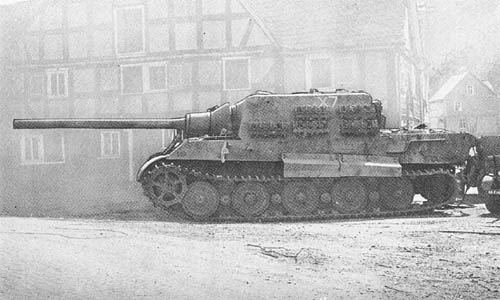
Information is being sought on this weapon.
SPECIFICATIONS
| Armament | 12.8 cm Pak 44 |
German: p. 40

Information is being sought on this weapon.
SPECIFICATIONS
| Armament | 12.8 cm Pak 44 |
German: p. 40

There are two versions of the 12.8 cm dual purpose, antitank/field gun, one manufactured by Rheinmetall and the other by Krupp. The Rheinmetall model has a slightly longer breech ring; the carriage has one rear axle and two front axles, whereas the Krupp model has one rear and one front axle. Reports indicatethat there may be a third version designated 12.8 cm K. 81.
The tube, of monobloc construction, is equipped with a cylindrical muzzle brake having perforations on both sides. The muzzle brake of the Krupp model is shorter and has the greater number of perforations. The manually operated breechblock is of the horizontal sliding type.
A variable hydropneumatic recoil mechanism is provided, the recoil and recuperator cylinder being carried within the cradle. Two hydropneumatic equilibrators, one on either side of the tube, compensate for muzzle preponderance.
The piece is mounted on a cruciform platform. The carriage, which incorporates torsion bar suspension, is jacked off the wheels in firing and, with the outriggers extended, a 360° traverse may be obtained. Elevating and traversing handwheels are fitted to both sides of the carriage, and a seat for the gunner is provided on the left.
A single shield is used with the Krupp gun, while the Rheinmetall version is equipped with a spaced shield. Both types, however, are angular in appearance and the sides are swept back towards the rear.
SPECIFICATIONS
| Rheinmetall | Krupp | |||
| Length of gun (including muzzle brake and breech ring) | 312 1/2 ins. | 299 ins. | ||
| Length of gun (including breech ring) | 277 1/2 ins. | 277 1/8 ins. | ||
| Length of chamber (from rifling) | 41 3/4 ins. | 41 3/4 ins. | ||
| Length of rifling | 219 1/2 ins. | 219 1/2 ins. | ||
| Overall length (traveling position) | not determined | 433 ins. | ||
| Overall width (traveling position) | 108 1/4 ins. | 98 ins. | ||
| Overall height (traveling position) | 81 ins. | 90 ins. |
German: p. 106.2 (August 1, 1945)

This weapon, together with the 8.8 cm Flak 41, is Germany’s standard heavy antiaircraft gun. There are four different type mounts used with the gun: mobile, static, railway, and a twin mounting. When used with the latter, the equipment is known as the 12.8 cm Flakzwilling.
In construction and appearance this weapon resembles the 10.5 cm antiaircraft gun described on page 109. The barrel consists of a three-piece tube with jacket and sleeve. The breech mechanism is of the horizontal sliding block type, and an electric firing device is used. A hydropneumatic recuperator is located above the barrel, and a hydraulic buffer below.
Elevating and traversing may be operated either by power or by handwheels; are located on the right side of the equipment with the layers seated facing the gun. A machine fuze setting gear and loading and ramming gear identical with those of the 10.5 cm Flak are used.
The static mounting is a pedestal type secured to a concrete base. The cradle pivots in trunnions mounted at the extreme rear of the upper carriage, and almost in line with the breechblock. A large box-like construction, located underneath the buffer and forward of the elevating arc, contains the oil motors. The equilibrators extend from an anchoring just forward of the trunnions to the forward edge of the casing containing the oil motors.
The gun being extremely high off the ground, platforms for the gun crew are provided. The gun is fitted to receive firing data by remote control transmission. A normal panoramic sight is provided as well as an antitank sight.
SPECIFICATIONS
| Caliber | 12.8 cm (5.04 ins.) | |
| Weight (static mount) | 28,600 lbs. | |
| Weight (traveling position) | 59,400 lbs. | |
| Mobile mount | ||
| Weight (firing position) | 37,400 lbs. | |
| Mobile mount | ||
| Length (traveling position) | 49 ft. | |
| overall | ||
| Length (firing position) | 29 ft. | |
| overall | ||
| Height (traveling position) | ||
| Height (firing position) | ||
| Height of trunnions (firing position) | 7 5/8 ft. | |
| Width (overall) | ||
| Length of piece | 308.5 ins. (61 calibers) | |
| Length of rifling | 255.13 ins. | |
| Twist of rifling (increasing) | 3° 20′ to 5° 30′ | |
| No. of grooves | 40 | |
| Width of grooves (forward section) | 0.26 in. | |
| (center section) | 0.25 in. | |
| Depth of grooves | 0.06 in. | |
| Width of lands (forward section) | 0.13 in. | |
| (center section) | 0.14 in. | |
| Muzzle velocity (H.E. shell) | 2,886 f/s | |
| Max. range (horizontal) | 20,950 meters (22,910 yds.) | |
| Max. ceiling at 85° | 14,800 meters (48,555 ft.) | |
| Rate of fire | 12 r.p.m. | |
| Traverse | 360° | |
| Elevation | 88° | |
| Depression | -3° | |
| Length of recoil | from 36 to 51 ins. | |
| Ammunition | A.P.C., H.E. | |
| Wt. of complete round (approx.) | 106 lbs. | |
| Wt. of H.E. projectile (12.8 cm Sprgr. Patr. I. 4.5) | 57 lbs. | |
| Wt. of A.P.H.E. projectile (12.8 cm Pzgr. Patr.) | 58.13 lbs. |
German: p. 106.1 (August 1, 1945)

The Jägdtiger was the most formidable self-propelled antitank gun used by the Germans. It consists of a 12.8 cm PJK 44 (L/55) (less muzzle brake), mounted on a Tiger B chassis.
The hull consists of the normal Tiger B with a builtup superstructure to form a fixed turret. The front plate of the superstructure is 250 mm thick and slopes back at 15° to the vertical. It is made of one solid piece of cast steel armor. The sides of the superstructure are made in one piece with the sloped sides of the fixed turret and, like the Tiger B, are 80 mm thick sloped at 25 degrees. The rear plate of the superstructure is also 80 mm thick with a 10° slope.
The main armament consists of a 12.8 cm PJK 44 set in the center of the front plate of the built-up superstructure. It has a cast, bell-shaped gun shield similar in design to that of the 8.8 cm Kw. K. 43 on the Tiger B. The spherical housing of the gun cradle mounting pivots on a steel ball. The gun is electrically fired and has a vertical sliding breechblock. Separate loading ammunition is used, and the same cartridge case is utilized for armor piercing and high explosive rounds.
With A.P.C. ammunition, penetration of approximately 6 inches of armor at 1,000 yards at 30° is effected; with A.P.C.B.C. ammunition, the penetration is approximately 8 inches.
SPECIFICATIONS
| Weight | 77 tons | |
| Length (overall) | 23 ft., 11 ins. | |
| Width (overall) | 12 ft., 7 ins. | |
| Height (overall) | 9 ft., 3 ins. | |
| Ground clearance | 19 ins. | |
| Tread centers | 103/110 ins. | |
| Ground contact | 13 ft., 4 ins. | |
| Width of track | 26/31 1/2 ins. | |
| Pitch of track | 5.9 ins. | |
| Track links | 92 (46 double shoes) | |
| Fording depth | 69 ins. | |
| Theoretical radius of action: | ||
| Roads | 106 miles | |
| Cross country | 75 miles | |
| Speed: | ||
| Roads | 23.6 m.p.h. | |
| Cross country | 10 m.p.h. | |
| Armor: | ||
| Front plate of superstructure | 250 mm at 15° to vertical | |
| Sides of superstructure | 80 mm at 25° to vertical | |
| Armament | 12.8 cm PJK 44 | |
| Ammunition | A.P.C.; A.P.C.B.C. | |
| Engine | Maybach HL 230 | |
| Transmission | 8 speeds forward; 4 reverse | |
| Steering | Two radius system | |
| Crew | 6 |
German: p. 40 (August 1, 1945)